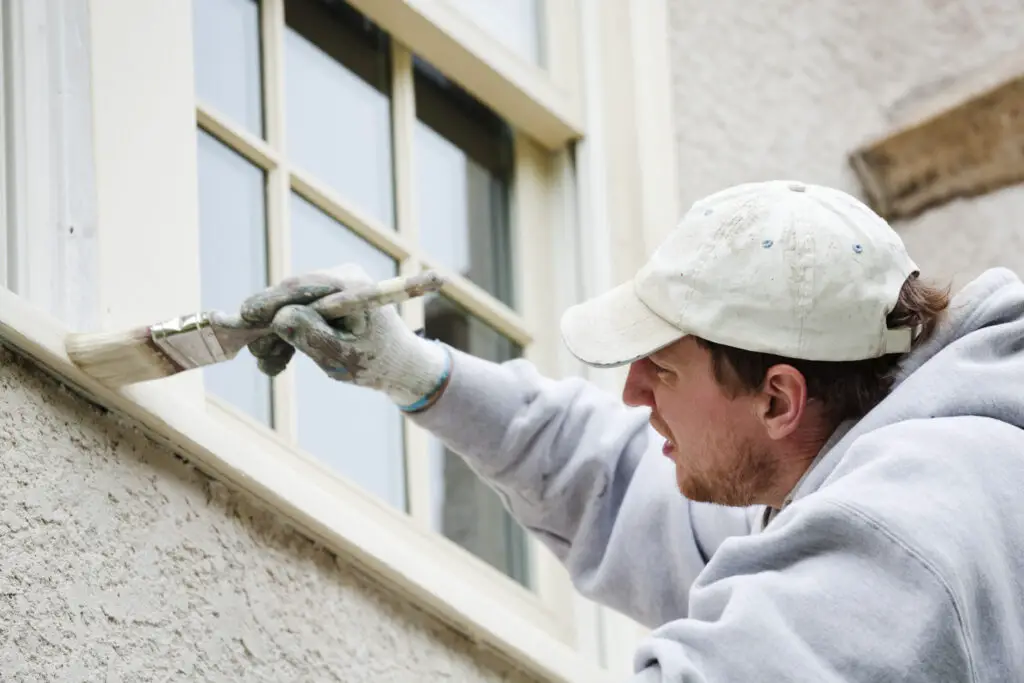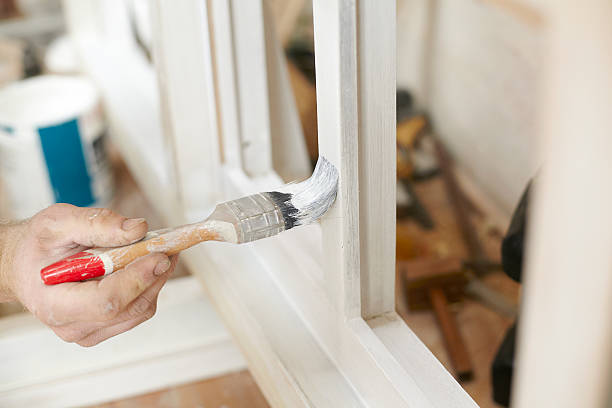A lot can be said about the aesthetic value of wooden window frames in a home. Not only do they add character and warmth to a house, but they also have a timeless charm that can’t be replicated by other materials.
However, with time, harsh weather conditions and constant exposure to sunlight can cause wooden window frames to deteriorate. Therefore, it is important to maintain and protect them to ensure they last for many years.
In this guide, we will discuss the process of painting a wooden window frame’s exterior to help you achieve a beautiful and long-lasting finish.
Materials Needed
- Paint – Acrylic paint or exterior latex paint in the color of your choice.
- Primer – A wood primer that is suitable for exterior use.
- Sandpaper – Medium to fine-grit sandpaper (120-220 grit).
- Paintbrushes – High-quality brushes specifically designed for painting trim and window frames.
- Drop cloth or plastic sheeting – To protect the surrounding area.
- Painter’s tape – To cover any areas that you do not want to paint.
- Cleaning supplies – Soap and water, or a degreasing cleaner such as trisodium phosphate (TSP).
- Safety equipment – Gloves, safety glasses, and a mask to protect yourself from fumes and dust
Preparation
Clear the surroundings: Start by removing any obstacles or items close to the window that could be damaged by paint spillage or splatter. This includes moving furniture, plant pots, or decorative items away from the work area.
Lay the drop cloth: Spread your drop cloth or plastic sheeting under the window frame to protect the wall and floor from drips and spills. Make sure it covers a large enough area to catch any debris from sanding as well.
Tape off the area: Apply painter’s tape around the window glass and any other areas adjacent to the window frame that you wish to keep paint-free. Ensure the tape is securely adhered to prevent paint from seeping underneath.
Clean the window frames: Use your cleaning supplies to remove dirt, grease, or mildew from the window frames. This important step ensures the paint adheres properly to the wood. If you’re using a chemical cleaner like TSP, remember to wear gloves and safety glasses for protection.
Sanding the frames: Once the frames are clean and dry, sand them down using your medium to fine-grit sandpaper. This will remove any old loose paint and create a smooth surface for the primer and paint to stick to. Wipe away any dust with a damp cloth after sanding.
Inspect the frames: Check for any cracks or damage on the wood. These should be filled with wood filler and allow it to dry before you proceed with painting.
Priming
Apply the Primer: Once your window frames are clean, sanded, and defect-free, it’s time to apply the primer. Primer serves as a preparatory coat that helps the paint adhere better to the surface and allows for a more vibrant color. Using your paintbrush, begin to apply the primer onto the frames.
Start at one corner and work your way around the frame, ensuring a smooth and even distribution of primer. Remember to cover all areas, including the sides and corners, to ensure a uniform paint job.
Let it Dry: After the primer has been applied, it’s crucial to let it dry thoroughly. The drying time can vary depending on the type of primer used, but typically a few hours should suffice.
The primer must be completely dry before you proceed with painting to avoid mixing the two layers, which could result in a muddy color or uneven finish.
Sanding After Priming: Once the primer is dry, lightly sand the frames one more time using fine-grit sandpaper. This step will smooth out any brush strokes or clumpy areas from the primer application and prepare the surface for the final coat of paint.
Cleaning up Post-Priming: After sanding, wipe down the frames with a clean, damp cloth to remove any dust or debris. This step ensures that your final paint application is smooth and dust-free. Once the frames are clean, you’re ready to move on to the final step – painting.
Painting

Choose the Right Paint: The type of paint you use is crucial for the durability and finish of your window frames. For wood frames, choose a high-quality acrylic latex paint. This type of paint is resistant to flaking, peeling, and direct sunlight, making it ideal for window frames.
Applying the Paint: Start at one corner of the frame and work your way across, ensuring an even application. Use a small brush for precision and avoid overloading your brush with paint to prevent drips. Two coats will usually give the best finish, but this can depend on the color you’re using and the type of paint.
Always allow the first coat to dry fully before applying the second to avoid any streaks or marks.
Let it Dry: Just as you did with the primer, allow the paint to dry fully. Depending on the type and brand of paint this could take anywhere from a few hours to a whole day.
Apply a Sealer (Optional): Once your paint is dry, you may choose to apply a sealer. This step can add an extra layer of protection and help your paint job last longer.
Cleaning up Post-Painting: Once the painting is done and thoroughly dried, clean up your workspace. Remove any painter’s tape, clean your brushes, and properly dispose of any leftover paint.
Drying and Cleaning Up
After the painting process, it’s important to allow ample time for the window frames to dry. The drying duration depends not only on the paint type and brand but also on the weather and room conditions.
Generally, the drying period can range from a few hours to a full day. It’s essential to avoid touching the painted surfaces during this time to prevent smudges or fingerprint marks.
While waiting for the paint to dry, you can start cleaning your workspace. Begin by carefully removing the painter’s tape. If the paint is still slightly wet, the tape can be removed without disturbing the paint lines.
Then, clean your brushes with warm soapy water, ensuring all the paint is rinsed out. Squeeze the bristles to remove excess water and let them dry naturally.
For any leftover paint, it’s crucial to dispose of it responsibly. If it’s water-based paint, it can be safely poured down the drain with running water.
For oil-based paints, however, you should check with your local council or recycling center regarding disposal procedures, as these can harm the environment if not disposed of correctly.
Maintenance
To ensure the longevity of your newly painted window frames, it’s essential to practice proper maintenance. This includes regularly cleaning the surfaces with a mild detergent and soft cloth and avoiding harsh chemicals that can damage the paint.
If you notice any chips or scratches in the paint, touch them up immediately to prevent further damage. It’s also recommended to inspect your window frames periodically for any signs of wear and tear and address them promptly.
Another way to maintain your window frames is by applying a fresh coat of paint every few years, depending on the condition of the paint and exposure to weather elements. This will not only keep your window frames looking new but also protect them from potential damage caused by moisture or sunlight.
In addition to regular maintenance, it’s essential to take preventive measures to protect your window frames. This includes using curtains or blinds to shield them from direct sunlight and avoiding contact with sharp objects or heavy items that can cause scratches or dents.
Related Topics:
Conclusion
Taking the time to properly prepare and paint your window frames can significantly improve the appearance of your home. With the right tools, techniques, and maintenance, your window frames can withstand weather elements and remain in excellent condition for years to come.
Remember to always prioritize safety and proper disposal methods when working with paint. Now you have the knowledge to confidently tackle any window frame painting project and enhance the curb appeal of your home. Happy painting!
FAQs
Can I paint my window frames any color?
Yes, you can choose any color that complements your home’s exterior. Just make sure to use high-quality paint specifically designed for outdoor use.
Do I need to prime my window frames before painting?
It’s highly recommended to use a primer before painting, especially if your window frames are made of wood or have previously been painted. This will ensure better adhesion and coverage of the paint.
How often should I repaint my window frames?
This depends on the condition of the paint and exposure to weather elements. It’s recommended to repaint every 3-5 years, but you may need to do it more frequently if you notice chipping, peeling, or fading. Remember to inspect your window frames regularly and touch up any damaged areas to prolong the life of your paint job.


1 thought on “Painting Wooden Window Frames Exterior”